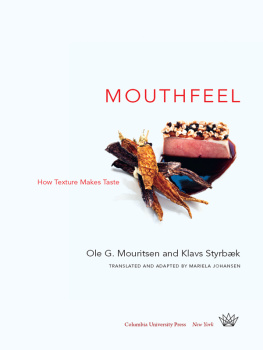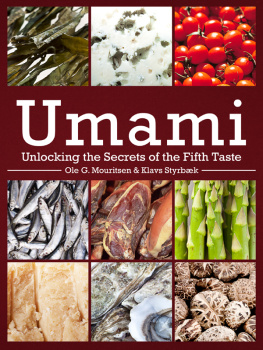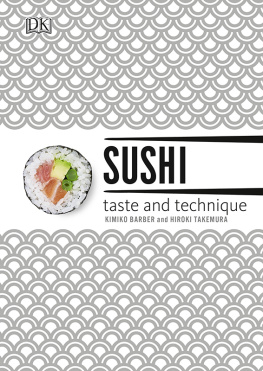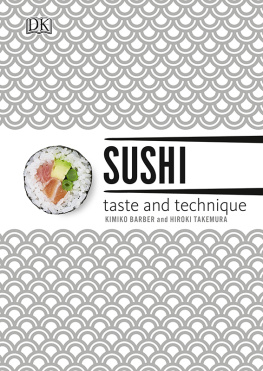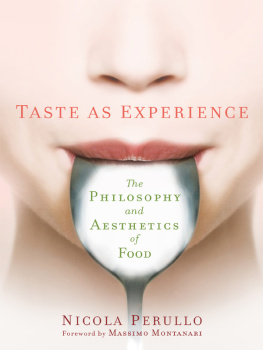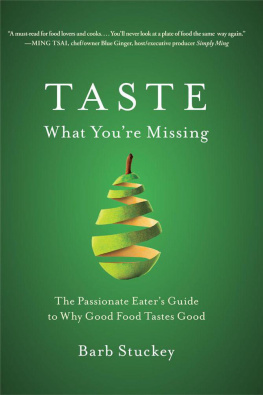Table of Contents
MOUTHFEEL
Arts and Traditions of the Table: Perspectives on Culinary History
MOUTHFEEL
How Texture Makes Taste
Ole G. Mouritsen and Klavs Styrbk
TRANSLATED AND ADAPTED BY MARIELA JOHANSEN
Columbia University Press
New York
Columbia University Press wishes to express its appreciation for assistance given by the Danish Arts Foundation toward the cost of publishing this book.
Columbia University Press
Publishers Since 1893
New York Chichester, West Sussex
cup.columbia.edu
Copyright 2017 Columbia University Press
All rights reserved
E-ISBN 978-0-23154-324-8
Library of Congress Cataloging-in-Publication Data
Names: Mouritsen, Ole G., author. | Styrbk, Klavs, author.
Title: Mouthfeel : how texture makes taste / Ole G. Mouritsen and Klavs Styrbk; translated and adapted by Mariela Johansen.
Other titles: Fornemmelse for smag. English | Mouth feel
Description: New York : Columbia University Press, 2017. | Series: Arts and traditions of the table : perspectives on culinary history | Translation of: Fornemmelse for smag. | Includes bibliographical references and index.
Identifiers: LCCN 2016032426 (print) | LCCN 2016032605 (ebook) | ISBN 9780231180764 (cloth : alk. paper) | ISBN 9780231543248 (e-book)
Subjects: LCSH: Food texture. | Taste. | FoodSensory evaluation. | Food preferences. | Cooking. | LCGFT: Cookbooks.
Classification: LCC TX546 .M6913 2017 (print) | LCC TX546 (ebook) | DDC 664/.072dc23
LC record available at https://lccn.loc.gov/2016032426
A Columbia University Press E-book.
CUP would be pleased to hear about your reading experience with this e-book at .
COVER IMAGES: iStock and Shutterstock, additional photos by Jonas Drotner Mouritsen
COVER DESIGN: Milenda Nan Ok Lee
CONTENTS
RECIPES
Why does eating a piece of chocolate that literally melts on the tongue give us such feelings of decadent pleasure? Why does a freshly prepared hot dog taste very different from one that has taken a trip through the blender? Why do most people prefer their eggs with bacon that is fried until it is crisp? And why is soda pop that has lost its fizz or beer that has gone flat so unappealing? These and many other questions about the sensory perceptions of tasteespecially the extent to which they are affected by how food feels in the mouthpiqued our curiosity and were the driving force that led us, a researcher and an experienced chef, to look beyond the chemical composition of a foodstuff and to think seriously about the physical impression it makes. We tackled the problem as a collaborative effort, using the kitchen as the laboratory in which we combined scientific critical thinking with creative intuition and in-depth knowledge about food preparation.
Taste is one of our most important senses. We depend on it to steer us away from ingredients that might be harmful or even poisonous and to guide us toward those that are palatable and nourishing. Here we may think that we are relying primarily on the five basic tastessour, sweet, salty, bitter, and umamiwhich we can describe quite easily. But we have considerably more difficulty in articulating, let alone remembering, the overall sensory impression made by a dish or a whole meal. This is partly because the interplay between taste and smell complicates matters. So does the presence of certain substances in food that are not true taste substances, but react with saliva and the mucous membranes. For example, tannins in red wine can induce a feeling of dryness in the mouth or capsaicin in chile peppers may be irritating or even cause pain. And what we often fail to grasp is the role played by the physical characteristics of what we put into our mouth and how we react to them. Even though this often happens quite subconsciously, it turns out that our liking a foodstuff or rejecting it is often more dependent on how it feels in our mouth, rather than on how it tastes or smells. This sensation is called mouthfeel and it relates to the texture of the food.
Without a doubt, a poor understanding of how taste works and the role of mouthfeel, especially when coupled with a lack of culinary skills, are contributing factors in our tendency to eat portions that are too big and too fattening. At the same time we are adding to our foods increasingly large amounts of sugar, salt, and fatsall of which have been linked to major dietary-related diseases that have taken on epidemic proportions in the past century. Taste is closely linked to appetite, digestion, and feelings of satiety, all of which lead to a natural regulation of food intake. Paradoxically this relates to two opposite effects: many otherwise healthy people have a poor diet and eat too much because the food is unpalatable and not naturally filling; and many who are sick and elderly eat too little because appetite falls off when the food is not tasty. This is a striking reminder of the important contribution that tasty food makes to what we think of as the good life.
It is thought-provoking that, on the one hand, items sold in supermarkets rarely carry any description of the taste or texture that goes beyond a reference to spiciness. On the other hand, the products are usually labeled with precise details about their places of origin, nutritional contents, calorie count, and so on, often supplied to comply with government regulations. And in many cases, taste impressions are derived from fast foods, snacks, soda pop, and candy, all of which have an impact on our health. We would like to see that changed and hope that this volume will help to promote the use of a more precise vocabulary for describing the taste of food, especially texture or mouthfeel.
The answers concerning why mouthfeel is so intimately linked to a healthy diet lead immediately to a host of new questions about what one needs to do to prepare raw ingredients and produce dishes that enhance this aspect of our daily food intake. How does one best thicken a soup or a sauce? How does one produce a crisp crackling on a pork roast? What is the secret of homemade mayonnaise? And how does one prepare vegetables so that they are cooked to perfection? In this book we have tried to provide answers to these and many other questions. We have designed it with several goals in mind: to give an overview of how mouthfeel fits into the perception of taste; to provide a popular introduction to the science underlying taste, mouthfeel, and texture, as well as a systematic review of the properties of raw ingredients that are fundamental to an appreciation of their structure, and with it, their mouthfeel; and to demonstrate the many ways in which mouthfeel can be altered. An extensive glossary and a detailed index are included as a quick reference for those who are not ready to delve too deeply into the science. Nevertheless, we hope that our search for a deeper scientific understanding will serve as a source of inspiration for experienced chefs, nutrition and wellness professionals, food entrepreneurs, and food enthusiasts so that they might join us in our goal of improving food culture as we experience it on a daily basis.

